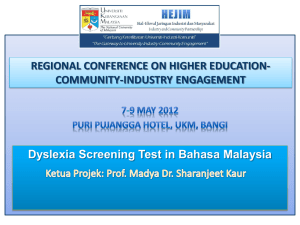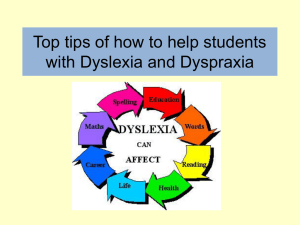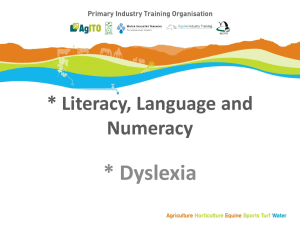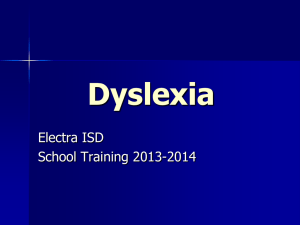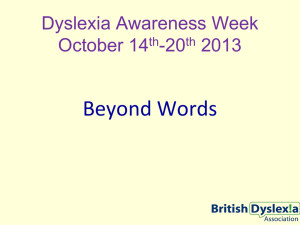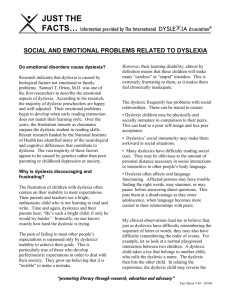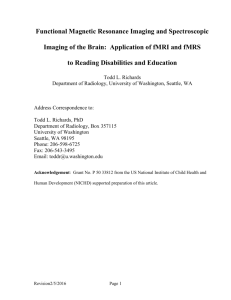Understanding Dyslexia - The Learning Staircase
advertisement
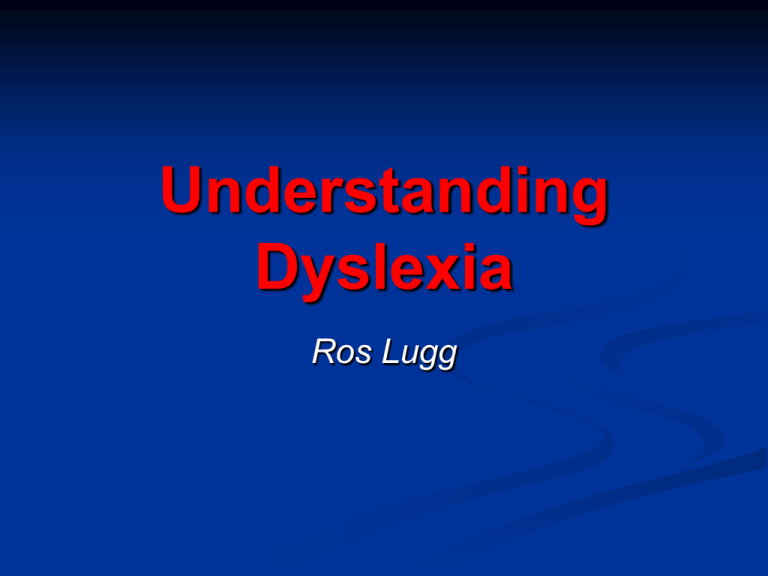
Understanding Dyslexia Ros Lugg Dyslexia or Specific Learning Disability? Other Specific Learning Disabilities ADHD (Attention Deficit Hyperactivity Disorder) Dyspraxia Dysphasia, speech/language delay or deficit Dyscalculia Autism/Aspergers Syndrome/Tourette Syndrome Developing awareness 1898 Pringle Morgan (Percy) 1920s onwards Samuel Orton Strephosymbolia Stein post-mortem evidence 2007 New Zealand recognises dyslexia! Types of dyslexia Developmental Dyslexia – inherited condition from birth. Affects approximately 10% of the population. Acquired Dyslexia – a result of brain injury “Dyslexia is a complex neurological condition which is constitutional in origin. The symptoms may affect many areas of learning and function, and may be described as a specific difficulty in reading, spelling and written language. …….oral language may be affected to some degree.” British Dyslexia Association 1996 Neurological and biological basis Brain structure MRI scanning results The planum temporale cortical language area, which is normally larger in the left hemisphere than in the right, is symmetrical in most dyslexics. The corpus callosum is physically less well developed in dyslexics than in nondyslexics. Nutritional aspects Dyslexics are less able to convert EFAs to myelin in the brain Males are more vulnerable than females to EFA deficiencies (Burdge et al 2002 + other studies) “Visual and auditory symptoms in dyslexia have been related to physical signs consistent with fatty acid deficiency.” (Taylor et al., 2000) “In children and adults, the same physical signs suggestive of fatty acid deficiency have also been linked with both dyslexia (Richardson et al., 2000) and autistic spectrum disorders (Bell, Sargent, Tocher & Dick, 2000, 2004).” Link between Dyslexia and EFAs Two groups of mothers – extensive questionnaire about diet while pregnant (particularly Omega 3 & 6 consumption) One group – dyslexic sons One group – non-dyslexic classmates Study found that: Mothers of children with dyslexia had consumed significantly less EFA while pregnant than mothers of non-dyslexic children. Supplementation with EFAs can be extremely effective Brain activation fMRI scanning results Dyslexics were scanned while doing a simple rhyming task. In normal readers, the left frontal cortex lit up, but this does not happen in dyslexics. Graduate dyslexics study Well-compensated graduate dyslexics studied. Equivalent non-dyslexic control group Simple rhyming task PET scan findings Both groups completed the tasks with no problem. Dyslexic group – very different pattern of brain activity: Less activity in Broca’s and Wernicke’s areas and no activity at all in the insula Conclusion A specific failure in that particular brain system connected with language persists into dyslexics’ adult lives, although their performance indicates that they were compensating well. Effect of correct remediation Several studies have shown that brain activation patterns can be changed with the right remediation – even in adults. Magnocellular pathways Dyslexic brains show abnormalities of the magnocellular component of the visual system, which is specialized for processing fast temporal information. Current conclusions “The evidence is consistent with an increasingly sophisticated account of dyslexia that does not single out either phonological or visual or motor deficits. Rather, temporal processing in all three systems seems to be impaired. Dyslexics may be unable to process fast incoming sensory information adequately in any domain.” Gene links Chromosome 6 (DCDC2) linked with dyslexia Chromosome 15 (KIAA0319) also implicated Genetic abnormalities in Broca’s and Wernicke’s areas (the main language areas in the left hemisphere) Heritability Dyslexia runs in families! If a boy’s father is dyslexic, he has a 40% chance of being dyslexic. If his mother is dyslexic, he has a 50% chance of being dyslexic. Boys are 4 times more likely to be dyslexic than girls. Links with other conditions Left-handedness Eczema Allergies Schizophrenia Dyspraxia ADHD Glue ear Irlen Syndrome Dyslexia and behaviour Internationally, 60 – 80% of prison populations are dyslexic Dyslexia causes huge anxiety and selfesteem problems, particularly with brighter pupils. This magnifies behavioural issues at school age and beyond. Fallacies about dyslexia “He’s not ready for reading yet. Wait until he’s ready and he’ll be fine.” Dyslexia doesn’t exist. It’s just a middleclass parent’s excuse for a thick child.” Possible Indicators Obvious ‘good’ or ‘bad’ days with no reason Confusion between directional words Difficulties with sequences, days, months, tables Family history Discrepancy between oral and written language Reversals/mis-sequencing letters Poor concentration Forgets or misunderstands instructions Has difficulty understanding what has been read Takes longer to do written work Slow processor Problems copying, particularly from the board Problems planning essays Poor confidence or self-esteem Poor social skills Can appear awkward or clumsy Very inconsistent abilities Unexpected difficulties with certain tasks Sometimes tongue-tied Anxious about answering questions in class Home and social implications Fatigue Homework Organisation Social isolation Possible strengths Innovative thinkers Excellent trouble shooters Intuitive problem solving Creative – arts, architecture, design, engineering Lateral thinkers Often excellent with computers Often brilliant ‘higher level’ mathematicians Famous dyslexics Alexander Graham Bell John Britten Thomas Edison Michael Faraday Erin Brockovich George Patton Orlando Bloom Tom Cruise Nelson Rockefeller Henry Ford Walt Disney Cher John Lennon Auguste Rodin Nigel Kennedy Henry Winkler Whoopi Goldberg Susan Hampshire Keanu Reeves Kiera Knightly Oliver Reed Robin Williams Leonardo da Vinci Picasso Andy Warhol Jackie Stewart Muhammed Ali Thomas Jefferson Winston Churchill J F Kennedy George Washington Agatha Christie W B Yeats Terry Goodkind Patterns of difficulty One feature of dyslexia is that there is no link between dyslexia and intelligence. There are typical patterns, but huge variability between individual difficulties. Perception and Processing Perception and Processing Model Input Reception v. Perception Comprehension, organization, retention Output Retrieval/planning/ expression Processing skills (The big 5) Motor development (fine and gross) Sequencing Phonological awareness Visual perception (Visual discrimination) Memory (working) Memory implications A non-dyslexic child takes between 4 and 10 exposures to a word to fix it in longterm memory. A dyslexic child can take anything between 500 and 1300 exposures. Therefore: teaching needs to incorporate huge amounts of ‘overlearning’ Understanding Memory Short v long-term memory Visual memory Auditory memory Kinaesthetic memory Working memory L Z T B W H S B L Z T B W H S B The furniture was highly polished Common language problems Interpretation – very literal, don’t understand ‘figures of speech’ Language of mathematics – “70% of dyslexics experience difficulty with number language words (sum, total, odd, take away)” Chasty 1985 Comprehension – reading and oral Other learning disabilities: Sensory Integration deficits Central Auditory Processing Disorder (CAPD) Global Learning Difficulty Dyslexic or low ability? Low ability profile Typical dyslexic profile More extreme dyslexic profile – very able but indicators of dyspraxia Dyslexic profile Low ability profile Low ability Very able, but major perceptual difficulties Assessment options Specialist assessment centres SPELD Step by Step Centre Assessment software – available in schools Teaching methods and resources All teaching needs to be: Highly structured Cumulative Multi-sensory Teaching needs to incorporate: Huge amounts of reinforcement/overlearning Activities to develop transfer Remediation or support? In-class support v. withdrawal Reader-writer/extra time Writing or word-processing/dictating Assistive Technology Reading Pen Hand-held scanner (wand) Flatbed scanner Dictaphone/PDA Laptop Spell checker (Franklin) Tape recorder Assistive Software TextHelp Dragon Naturally Speaking Thinksheet Remedial Unit Experienced teacher v teacher aide? Computers Adequate resourcing (including structured literacy scheme) Identify early and then blitz problems – don’t trickle-feed!



